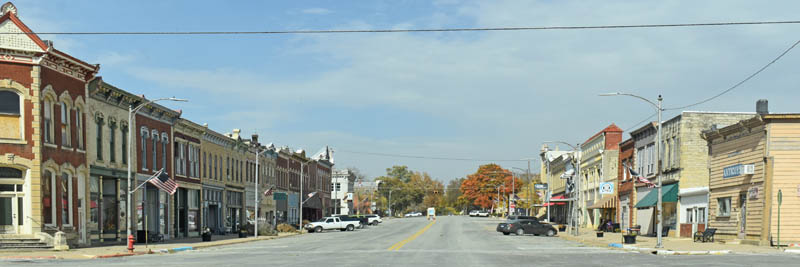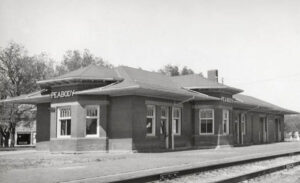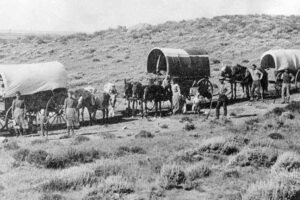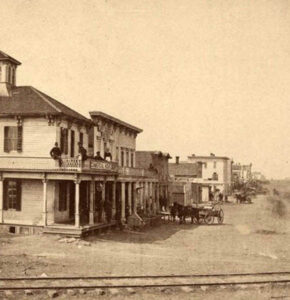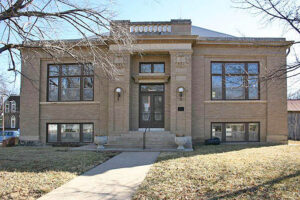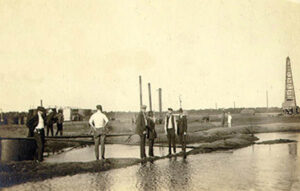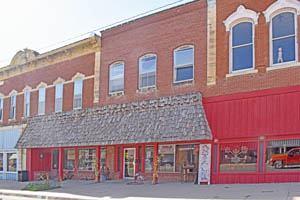Peabody, Kansas, is a small town in Catlin and Peabody Townships on Doyle Creek in Marion County. As of the 2020 census, its population was 937. It was named for F.H. Peabody of Boston, Massachusetts, a former vice president of the Atchison, Topeka & Santa Fe Railroad.
In 1864, the first settler in the area was W.C. Coble, from North Carolina, who set up ranch headquarters about two miles east of the current city. A colony of settlers from Wisconsin was the first settlers in September 1870. The pioneers came before the railroad and lived for several weeks in tents. During the first month, the colony officers laid out a town and surveyed it into lots. The town was named Coneburg after the town company president, John Cone. In October, more settlers arrived. That winter, some settlers returned east to get supplies and bring out their families.
A post office was established in Coneburg on January 25, 1871. On February 15, 1871, J. E. Cone, W. C. Nye, C. D. Bradley, F. H. Hopkins, and M. Birdsall filed for record on a town plat.
In 1871, the Atchison, Topeka, and Santa Fe Railway extended a main line from Emporia through Peabody to Newton. In the spring of that year, T.M. Potter and five other men started the Peabody Town Company. That year, Kolloch and Waller Chenault formed the Kolloch Chenault Bank, later the First National Bank. During the 1870s, Kolloch served as a judge. Chenault was the local public notary. Kolloch and Chenault were local real estate representatives for the Santa Fe Railroad.
By May 1871, Coneburg had at least two “boarding houses, a lumber yard, two grocery stores, a dry goods store, a drug and grocery store, a boot and shoe store, an agricultural implement house, a
blacksmith shop,” and approximately 12 dwellings.
In June 1871, the town of Peabody was platted just to the south of Coneburg, and it included the land where the railroad was built on June 9. S. N. Robinson was President of the town company; R. . Taber was secretary. Since the land title for the Peabody town site had no legal disputes, businesses immediately moved from Coneburg. The first depot was built south of the tracks. Later, a train wreck destroyed it, and a second depot was built on the north side of the tracks. On October 30, 1871, the Coneburg post office was moved to Peabody, and its name was changed. The mail was carried to and from the post office at Florence. At that time, regular trains began running on the road, and the town gained a new momentum.
By July 1871, the population of the combined communities was approximately 500 people who occupied about 75 dwellings in the vicinity. That year, the Shaft, a weekly newspaper, was established by W.H. Morgan.
During most of the 1870s, the railway depots in Peabody and Florence were the only access points for train passengers into Marion County and northern Butler County. Peabody was a destination for numerous foreign homesteaders, including the Mennonite settlers around Goessel and Gnadenau.
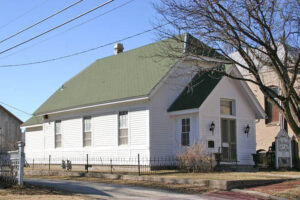
The first library in Peabody, Kansas, now serves as a museum. It is listed on the National Register of Historic Places. Photo courtesy Kansas State Historical Society.
In April 1872, during legal disputes, Coneburg became North Peabody. That year a large stone structure was built in 1872 for school purposes. Professor L. M. Knowles, one of the State’s best educators, was the school Principal, and there were four other teachers.
In 1873, three westbound trains and three eastbound trains stopped at the Peabody depot. That year, the first issue of the Peabody Gazette was printed by J. P. Church.
In May 1874, F.H. Peabody visited the new town. At that time, he announced he would donate money for a library building, furniture, books, periodicals, and landscaping if the Peabody Township would secure four town lots for the site. The construction contract was awarded in the spring of 1875. It was opened to the public in June 1875, with Mrs. Kincaid as the librarian. New books are constantly added to the library, and the reading room was well-supplied with newspapers and periodicals. In February 1876, the state legislature authorized the township to levy a tax to support the library. The structure housed the library facilities until 1914 when a new Peabody Township Carnegie Library was constructed on the old location.
A revised plat of Peabody was made on July 5, 1875.
In 1875, Peabody held its first agricultural “county fair” at their 20-acre fairgrounds and continued to hold them annually for many years.
A continual stream of emigrant wagons passed through Peabody daily in 1878. Peabody was incorporated as a third-class city on March 15, 1878. By April 1878, the population of Peabody was 525. A supplemental plat of North Peabody was made on April 27, 1878. Because of the disputes, the street that ran down the middle of the border between the two towns was called “Division Avenue.” The two towns merged into the city of Peabody in 1879. That year, Peabody was incorporated as a city of the third class. As a marketplace, it had the advantage of having Western and Eastern outlets. Butter, eggs, poultry, and baled hay found their way to the mining towns of Colorado and New Mexico, with ten elevators and cattle yards as evidence of the extensive grain and stock shipments to the East.
Between April and September 1878, more than 40 new dwellings were built, and demand for additional housing still exceeded the supply. The commercial district began near the Santa Fe Depot.
By 1879, the school population had increased, and a large frame building was erected just north of the existing school.
Illumination was added to the commercial district of Peabody in 1879. On September 12, 1879, coal oil lamps were installed along Walnut Street. In the 1880s, electric lights became commonplace throughout America, replacing the earlier oil and arc lights.
In the early 1880s, Peabody had a Quartette Band, a Cornet Band, a Lotus Club, a Post of the Grand Army of the Republic, Knights of Honor, Odd fellows, and Masonic organizations. It also had a Co-operative Temperance Union. Frank McKircher was the station agent; J. M. Amborn had the nursery west of the city.
By 1881, most of the lots in the business sector had standing structures upon them, many of which were single-story, frame buildings. In 1882, a total of 125 buildings existed in Peabody.
The city authorities for 1882 were: Mayor, F. C. Bush; Councilmen, G. W. Neal, C. Hanlenbeck, F. B. McKercher, A. K. Stewart, and D. J. Roberts; Police Judge, J. M. Holcomb; City Attorney, G. W. Camp, Clerk, G. W. Camp; Treasurer, F. H. Kollock, Marshal, E. S. Crisfield.
In 1883 Peabody had three hotels, two banks, four drug stores, seven general stores, one flour and feed store, two barber shops, four real estate, insurance, and loan agencies, two meat markets, four blacksmith and wagon shops, two grocery establishments, two bakeries, and confectioneries, two hardware and farm implement establishments, one foundry and machine shop, one carriage and paint shop, three millinery establishments, one livery stable, two dealers in books, periodicals, and stationery, six carpenters and builders, an auctioneer, photographer, dentist, three physicians, a merchant tailor, two boot and shoemakers, a mason and contractor, three lumber dealers, two cola dealers, a house painter and paper-hanger, a jeweler, a gunsmith, a furniture dealer and undertaker, a veterinary surgeon, and a poultry yard proprietor.
On January 7, 1885, city bonds were approved for constructing a city waterworks. The railroad companies contracted with the city to supply their water needs. From the highest point of the city, a well was dug to a depth of approximately 40 feet. The U.S. Wind Engine and Pump Company received the contract to erect a windmill, tower, elevated tank, pipes, hydrants, hose, and hose cart. Powered by a windmill, the water tank was filled nearly every day, and an engine was included in case of emergency. Two-and-one-half miles of pipe were laid along the principal streets, including Walnut Street, and attached to 25 hydrants. In January 1898, a windstorm destroyed the water tower. Six months later, a steel, 16-foot windmill and 60-foot tower were installed as replacements.
In September 1885, the Kansas State Fair was held at Peabody during the first four days of the month. An outstanding feature of the state fair was “the First Monument to General Grant,” who died shortly before the fair. The temporary monument was an obelisk about 40 feet tall and built from 40 bushels of ears of corn. The fair had a grandstand, which could hold 2000 people, to view horse races. The race track was used for various events, including horse walking teams in harness, trotting, running, pacing, mule racing, and daily chariot races. A dining hall was built that could feed 10,000 people each day.

1884 Peabody Bank, at 101 N Walnut Street. It served as a bank until 1922. Photo courtesy Wikipedia.
In 1887, the Chicago, Kansas, and Nebraska Railway built the “Rock Island” branch line north-south from Herington through Peabody and Wichita to Caldwell. That year, the obsolete oil light fixtures were replaced with arc lights, one of the earliest electric systems available. Arc lights flicked like flames, giving them a more natural appearance. On September 14, arc lights were tested on a corner building in the business district. The event drew a crowd the following evening that congested the street as nearly all the main stores were illuminated by arc lights, leading residents to claim the stores were “better lighted at night than during the day.”
In February 1888, town leaders boasted the community had its own “water works, telephone lines, electric lights, and all improvements usually found in a city of 10,000 people.
By 1893, this branch line was incrementally built to Fort Worth, Texas. It foreclosed in 1891 and was taken over by the Chicago, Rock Island, and Pacific Railway.
Peabody was the home of famous racehorses around the turn of the century. Three of the more famous horses were world champions. Joe Young, known as the “iron horse,” sold for $10,000 by C.E. Westbrook, the first horse west of the Mississippi River to sell for such a high price. Joe Young sired Joe Patchen in 1889, who earned his owner $40,000 in race purses and then was sold for $44,000. Joe Patchen sired Dan Patch in 1896, a horse that sold in 1907 for $60,000.
In 1899, a phone system was implemented by J.E. Wright, which rented phones to subscribers for $1.00 a month for private phone lines and $2.00 for business lines.
Mennonite Migration
In 1900, the Marion County Agricultural Society sold the fairgrounds to the city, which was renamed the Peabody City Park.
Electric street lights were installed by Thomas Osborne, the owner of the Osborne Building, in about 1906. These first lamps of Osborne’s consisted of four carbon arc lights which were placed in the
commercial district.
Before 1910, several progressives campaigned nationally for better roads for automobiles. These individuals succeeded in creating the New Santa Fe Trail Highway, built by local communities that wanted to be included along the route of the thoroughfare. From Emporia, the road went west through Saffordville, into Strong City, south two miles to Cottonwood Falls, west over the hill to Elmdale, then southwest through Clements, Cedar Point to Florence, west from Florence to a point four miles north of Peabody, where it turned south into Peabody along Walnut Street before making its way to Walton and Newton. The road, which followed the route of the Santa Fe Railroad, was graded and dragged. The road was later sanded, a state in which it remained until the current U.S. Highway 50 was constructed.
The impact of the highway on Peabody was immediate. In October 1910, the first automobile garage along the New Santa Fe Trail Highway west of Emporia opened in Peabody. The facility provided a repair shop, a fully steam-heated parking garage, an automobile dealership, and a full line of accessories, including oil, tires, and batteries. Several gas stations were also established.

Peabody, Kansas Main Street, 1908. Touch of color by LOA.
In 1910, Peabody was the second-largest town in Marion County. It was at the junction of the Atchison, Topeka & ‘Santa Fe and the Chicago, Rock Island & Pacific Railroads. At that time, it was one of the most progressive little cities in Kansas. It has electric lights, a waterworks, a fire department, an opera house, a public library, a creamery, a windmill factory, two banks, and a weekly newspaper called the Peabody Gazette. Some of the largest shipments of hogs and cattle in the state.were made from this point. It also had express and telegraph offices, an international money order post office with five rural routes, and a population of 1,416.
Having become an important supply point for one of the state’s cattle feeding districts, approximately 20,000 head of cattle were imported from other states and fed within 20 miles of Peabody at 50 farms by 1911. Most of the cattle brought in for temporary grazing on the grasses of the Flint Hills came from New Mexico, Arizona, Colorado, and Texas. At least 50 cattle-feeding enterprises existed near Peabody. These concerns included cattle yards and pens to handle all herd sizes. Because of the cattle industry, local farmers grew corn, alfalfa, and other feed crops. The cattle were shipped to Kansas City, Kansas; Chicago, Illinois; and St. Joseph, Missouri, aboard 53 Rock Island Railroad livestock cars and 455 Santa Fe cars.
In 1912, the simple white frame building that housed the public library that flourished since its conception in 1874 was becoming too crowded for the growing town of Peabody. Needing a new building, the Commercial Club appointed a committee to apply for a Carnegie grant. By the spring of 1913, the Carnegie Corporation had agreed to grant $10,000. The agreed-upon building plan was patterned after the Carnegie Library of Galena, Illinois. It opened on Saturday, April 18, 1914. Today, it still functions as Peabody’s public library. The original simple white frame building was rescued and restored in 1927 and later moved to its current position just to the East of the present Carnegie building in 1960. It now serves as the Peabody Historical Museum.
The Peabody and Watchorn areas experienced an oil boom from 1918 to 1920 in the oil fields of the Mid-Continent oil province. The influence of the petroleum industry remained strong in Peabody and resulted in the greatest change in the community in the shortest time. More than 100 residences were constructed in October and November 1919. From 1918 to 1919, the population increased by 75% or more but later decreased as oil booms in other Kansas areas needed the workers. Currently, Watchorn is a ghost town consisting of oil wells but no remaining historical structures.
Peabody’s population peaked in 1920 at 2,455.
In 1925, three westbound and four eastbound trains made stops at Peabody.
In 1943, German and Italian prisoners of World War II were brought to Kansas and other midwest states as a means of solving the labor shortage caused by American men serving in the war effort. Large prisoner-of-war camps were established in Kansas at Camp Concordia, Camp Funston at Fort Riley, and Camp Phillips at Salina under Fort Riley. Fort Riley also established 12 smaller branch camps, including Peabody and El Dorado. Up to 150 prisoners were quartered at the Peabody branch camp. Farmers were to have priority over other industries in requesting prisoner labor. No fewer than four prisoners could be assigned to a farm, and a guard accompanied each group, but later, it was common for no guards to accompany the prisoners. The prisoners were not allowed to operate any powered farm equipment. The farmer collected the workers at the camp and returned them at the end of each day. The Peabody branch camp #101 was in the Eyestone building at 122 West 2nd Street. The prisoner yard was located in the northeast corner of the property and still exists as a storage area. The camp was closed in December 1945 after Germany surrendered.
The community gradually increased as a commuter town to support aircraft industries in Wichita during World War II and the Soviet Union’s Cold War years.
There have been numerous floods during the history of Peabody. In June and July 1951, due to heavy rains, rivers and streams flooded numerous cities in Kansas, including Peabody. Many reservoirs and levees were built in Kansas in response to the Great Flood of 1951.
The Chicago, Rock Island, and Pacific Railway depot in Peabody was demolished in the early 1960s. The Atchison, Topeka & Santa Fe Railroad depot was demolished in the 1970s after passenger transportation ended. The land was then converted into Santa Fe Park at the south end of Walnut Street.
The Chicago, Rock Island, and Pacific Railway shut down in 1980 and reorganized as the Oklahoma, Kansas, and Texas Railroad. The company merged in 1988 with Missouri Pacific Railroad, finally merging in 1997 with Union Pacific Railroad.
In 1996, the Atchison, Topeka, and Santa Fe Railway merged with Burlington Northern Railroad and was renamed Burlington Northern and Santa Fe Railway.
In 1998, Peabody Downtown Historic District was placed on the National Register of Historic Places. Before that time, Peabody had four previous listings on the register, including the Peabody Historical Library Museum in 1973, Peabody Township Library in 1987, J.S. Schroeder Building in 1991, and W.H. Morgan House in 1996. In 2012, Peabody City Park was placed on the National Register of Historic Places.
In 2010, the Peabody Main Street Association received five state awards. In the same year, Phase II of the Keystone-Cushing Pipeline was constructed 4.5 miles east of Peabody, north to south through Marion County. There was controversy over road damage, tax exemption, and environmental concerns should a leak occur.
Currently, Amtrak’s Southwest Chief passenger train passes through Peabody twice each day but stops at nearby Newton.
Peabody is well known in the region for its Independence Day Celebration on July 4 and its historic 1880s downtown Main Street.
In the scenic Flint Hills and Great Plains, Peabody is located 16 miles southwest of Marion, Kansas, and 15 miles northeast of Newton, along U.S. Highway 50.
© Kathy Alexander/Legends of Kansas, updated October 2023.
Also See:
Santa Fe Trail in Marion County
Santa Fe Trail – Highway to the Southwest
Sources:
Blackmar, Frank W.; Kansas: A Cyclopedia of State History, Vol I; Standard Publishing Company, Chicago, IL 1912.
Cutler, William G; History of Kansas; A. T. Andreas, Chicago, IL, 1883.
Peabody, Kansas
Wikipedia

